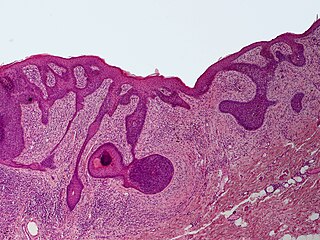Related Research Articles
Papular mucinosis is a rare skin disease. Localized and disseminated cases are called papular mucinosis or lichen myxedematosus while generalized, confluent papular forms with sclerosis are called scleromyxedema. Frequently, all three forms are regarded as papular mucinosis. However, some authors restrict it to only mild cases. Another form, acral persistent papular mucinosis is regarded as a separate entity.

Lupus erythematosus is a collection of autoimmune diseases in which the human immune system becomes hyperactive and attacks healthy tissues. Symptoms of these diseases can affect many different body systems, including joints, skin, kidneys, blood cells, heart, and lungs. The most common and most severe form is systemic lupus erythematosus.
Alopecia mucinosa is a skin disorder that generally presents, but not exclusively, as erythematous plaques or flat patches without hair primarily on the scalp, neck and face. This can also be present on the body as a follicular mucinosis and may represent a systemic disease.
Lichen scrofulosorum is a rare tuberculid that presents as a lichenoid eruption of minute papules in children and adolescents with tuberculosis. The lesions are usually asymptomatic, closely grouped, skin-colored to reddish-brown papules, often perifollicular and are mainly found on the abdomen, chest, back, and proximal parts of the limbs. The eruption is usually associated with a strongly positive tuberculin reaction. Of the three tuberculids, the incidence of lichen scrofulosorum was found to be the lowest (2%) in a large study conducted in Hong Kong. This highlights its rarity and significance as an important marker of undetected tuberculosis.
Lichen myxedematosus is a group of cutaneous disorders considered mucinoses. Conditions included in this group are:
Mucinoses are a group of cutaneous diseases caused by fibroblasts producing abnormally large amounts of acid mucopolysaccharides, usually hyaluronic acid.
Discrete papular lichen myxedematosus is a skin condition caused by fibroblasts producing abnormally large amounts of mucopolysaccharides characterized by the occurrence of waxy, flesh-colored papules.
Acral persistent papular mucinosis is a skin condition caused by fibroblasts producing abnormally large amounts of mucopolysaccharides, characterized by bilaterally symmetrical, flesh-colored papules localized to the hands and wrists.
Self-healing papular mucinosis is a skin condition caused by fibroblasts producing abnormally large amounts of mucopolysaccharides, and may present in adult and juvenile forms. The juvenile variant is also called self-healing juvenile cutaneous mucinosis.
Papular mucinosis of infancy is a skin condition caused by fibroblasts producing abnormally large amounts of mucopolysaccharides, characterized by skin-colored or translucent papules.
Cutaneous focal mucinosis is a skin condition characterized by a solitary nodule or papule.

Majocchi's granuloma is a skin condition characterized by deep, pustular plaques, and is a form of tinea corporis. It is a localized form of fungal folliculitis. Lesions often have a pink and scaly central component with pustules or folliculocentric papules at the periphery. The name comes from Domenico Majocchi, who discovered the disorder in 1883. Majocchi was a professor of dermatology at the University of Parma and later the University of Bologna. The most common dermatophyte is called Trichophyton rubrum.

Perifollicular fibroma is a cutaneous condition, a benign tumor usually skin colored, most often affecting the face and upper trunk.
Quadrichrome vitiligo is another variant of vitiligo, a cutaneous condition, which reflects the presence of a fourth color at sites of perifollicular repigmentation.
Urticaria-like follicular mucinosis is a rare cutaneous disorder that occurs primarily in middle-aged men.
Stiff skin syndrome is a cutaneous condition characterized by ‘rock hard’ induration, thickening of the skin and subcutaneous tissues, limited joint mobility, and mild hypertrichosis in infancy or early childhood. Immunologic abnormalities or vascular hyperactivity are not present in patients.
Nodular lichen myxedematosus is a cutaneous condition characterized by multiple nodules on the limbs and trunk, with a mild or absent papular component.
Cutaneous lupus mucinosis is a cutaneous condition characterized by lesions that present as asymptomatic skin-colored, at times reddish, 0.5–2 cm papules and nodules.
Eccrine mucinosis is a cutaneous condition characterized by mucinosis, and described in HIV-infected patients.
References
- ↑ Rapini, Ronald P.; Bolognia, Jean L.; Jorizzo, Joseph L. (2007). Dermatology: 2-Volume Set. St. Louis: Mosby. ISBN 978-1-4160-2999-1.
- ↑ Maktabi, Azza M. Y.; Helmi, Adel Ayman; Alkatan, Hind Manaa; Alrashed, Saleh Hamad (2018-08-01). "Focal perifollicular mucinosis of the eyelid presenting as a benign nevus". Canadian Journal of Ophthalmology. 53 (4): e149–e151. doi: 10.1016/j.jcjo.2017.10.037 . ISSN 0008-4182. PMID 30119811.